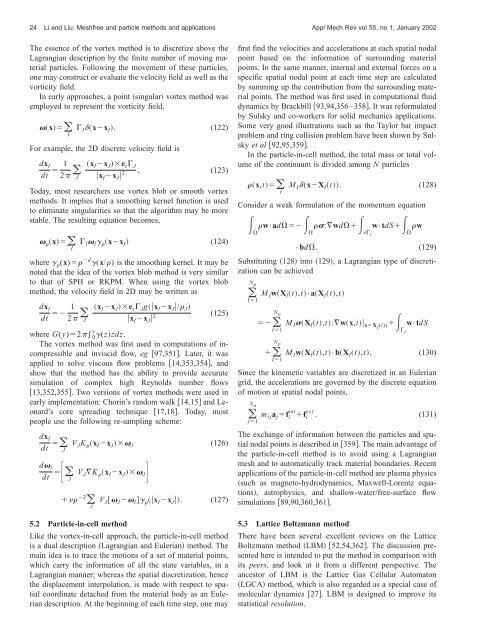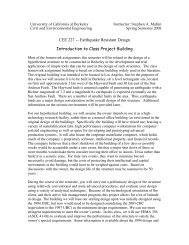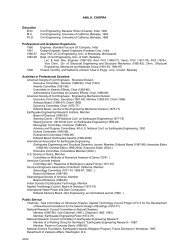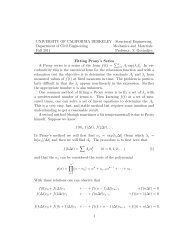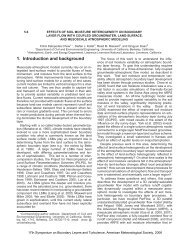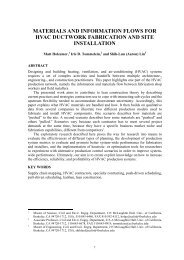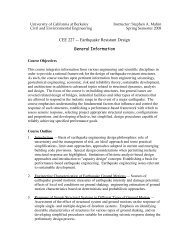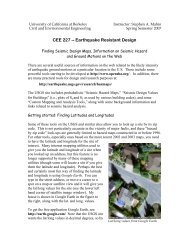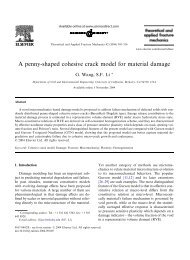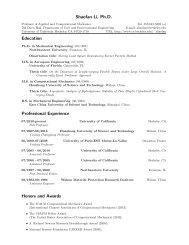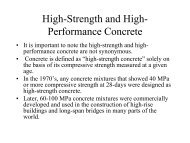Meshfree and particle methods and their applications - TAM ...
Meshfree and particle methods and their applications - TAM ...
Meshfree and particle methods and their applications - TAM ...
Create successful ePaper yourself
Turn your PDF publications into a flip-book with our unique Google optimized e-Paper software.
24 Li <strong>and</strong> Liu: <strong>Meshfree</strong> <strong>and</strong> <strong>particle</strong> <strong>methods</strong> <strong>and</strong> <strong>applications</strong> Appl Mech Rev vol 55, no 1, January 2002<br />
The essence of the vortex method is to discretize above the<br />
Lagrangian description by the finite number of moving material<br />
<strong>particle</strong>s. Following the movement of these <strong>particle</strong>s,<br />
one may construct or evaluate the velocity field as well as the<br />
vorticity field.<br />
In early approaches, a point singular vortex method was<br />
employed to represent the vorticity field,<br />
x<br />
I<br />
I xx I . (122)<br />
For example, the 2D discrete velocity field is<br />
dx I<br />
dt 1<br />
2 J<br />
x I x J e z J<br />
x I x J 2 . (123)<br />
Today, most researchers use vortex blob or smooth vortex<br />
<strong>methods</strong>. It implies that a smoothing kernel function is used<br />
to eliminate singularities so that the algorithm may be more<br />
stable. The resulting equation becomes,<br />
x<br />
I<br />
I I xx I (124)<br />
where (x) d (x/) is the smoothing kernel. It may be<br />
noted that the idea of the vortex blob method is very similar<br />
to that of SPH or RKPM. When using the vortex blob<br />
method, the velocity field in 2D may be written as<br />
dx I<br />
dt 1<br />
2 J<br />
x I x J e z J gx I x J / J <br />
x I x J 2 (125)<br />
where G(y)2 0 y (z)zdz.<br />
The vortex method was first used in computations of incompressible<br />
<strong>and</strong> inviscid flow, eg 97,351. Later, it was<br />
applied to solve viscous flow problems 14,353,354, <strong>and</strong><br />
show that the method has the ability to provide accurate<br />
simulation of complex high Reynolds number flows<br />
13,352,355. Two versions of vortex <strong>methods</strong> were used in<br />
early implementation: Chorin’s r<strong>and</strong>om walk 14,15 <strong>and</strong> Leonard’s<br />
core spreading technique 17,18. Today, most<br />
people use the following re-sampling scheme:<br />
dx I<br />
dt V J K x I x J J (126)<br />
J<br />
V J K x I x J J<br />
d I<br />
dt<br />
<br />
J<br />
2 <br />
J<br />
V J J I x I x J . (127)<br />
5.2 Particle-in-cell method<br />
Like the vortex-in-cell approach, the <strong>particle</strong>-in-cell method<br />
is a dual description Lagrangian <strong>and</strong> Eulerian method. The<br />
main idea is to trace the motions of a set of material points,<br />
which carry the information of all the state variables, in a<br />
Lagrangian manner; whereas the spatial discretization, hence<br />
the displacement interpolation, is made with respect to spatial<br />
coordinate detached from the material body as an Eulerian<br />
description. At the beginning of each time step, one may<br />
first find the velocities <strong>and</strong> accelerations at each spatial nodal<br />
point based on the information of surrounding material<br />
points. In the same manner, internal <strong>and</strong> external forces on a<br />
specific spatial nodal point at each time step are calculated<br />
by summing up the contribution from the surrounding material<br />
points. The method was first used in computational fluid<br />
dynamics by Brackbill 93,94,356–358. It was reformulated<br />
by Sulsky <strong>and</strong> co-workers for solid mechanics <strong>applications</strong>.<br />
Some very good illustrations such as the Taylor bar impact<br />
problem <strong>and</strong> ring collision problem have been shown by Sulsky<br />
et al 92,95,359.<br />
In the <strong>particle</strong>-in-cell method, the total mass or total volume<br />
of the continuum is divided among N <strong>particle</strong>s<br />
x,t<br />
I<br />
M I xX I t. (128)<br />
Consider a weak formulation of the momentum equation<br />
<br />
<br />
w•ad<br />
<br />
:wd<br />
t<br />
w•tdS<br />
<br />
w<br />
•bd. (129)<br />
Substituting 128 into 129, a Lagrangian type of discretization<br />
can be achieved<br />
N p<br />
I1<br />
M I wX I t,t•aX I t,t<br />
N p<br />
<br />
I1<br />
<br />
I1<br />
M I X I t,t:wx,t xXI (t))<br />
t<br />
w•tdS<br />
N p<br />
M I wX I t,t•bX I t,t. (130)<br />
Since the kinemetic variables are discretized in an Eulerian<br />
grid, the accelerations are governed by the discrete equation<br />
of motion at spatial nodal points,<br />
N n<br />
m ij a j f i int f i ext . (131)<br />
j1<br />
The exchange of information between the <strong>particle</strong>s <strong>and</strong> spatial<br />
nodal points is described in 359. The main advantage of<br />
the <strong>particle</strong>-in-cell method is to avoid using a Lagrangian<br />
mesh <strong>and</strong> to automatically track material boundaries. Recent<br />
<strong>applications</strong> of the <strong>particle</strong>-in-cell method are plasma physics<br />
such as magneto-hydrodynamics, Maxwell-Lorentz equations,<br />
astrophysics, <strong>and</strong> shallow-water/free-surface flow<br />
simulations 89,90,360,361.<br />
5.3 Lattice Boltzmann method<br />
There have been several excellent reviews on the Lattice<br />
Boltzmann method LBM 52,54,362. The discussion presented<br />
here is intended to put the method in comparison with<br />
its peers, <strong>and</strong> look at it from a different perspective. The<br />
ancestor of LBM is the Lattice Gas Cellular Automaton<br />
LGCA method, which is also regarded as a special case of<br />
molecular dynamics 27. LBM is designed to improve its<br />
statistical resolution.


